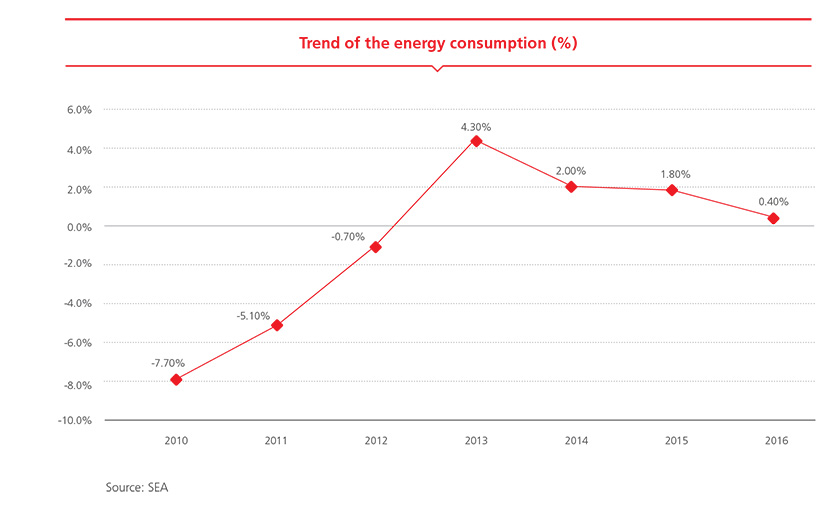Energy consumption
As part of SEA's Energy Management System and its ISO 50001 certification, SEA Group's energy consumption management is based on the following principles:
- energy must be produced while respecting and protecting the environment;
- reducing environmental impact and improving environmental performance are among the criteria of our business strategies, including infrastructural development;
- awareness among employees, partners, suppliers, contractors and stakeholders regarding environmental impact of their activities is a central item for environmental performance improvement at both airports.
System provides for the settlement of an Energy Team and, for the integrated management of most technical aspects, a Technical Group (which also includes representatives of SEA Energia). Involvement of all functions directly related to different aspects (design, implementation, maintenance and environmental management structure) ensures the necessary overview of processes and thus the identification of the most appropriate intervention proposals.
The main energy-saving measures for the year 2016 were:
- switching off unused flying runway lights at night, according to noise reduction scenario;
- introducing energy-efficient lighting;
- optimizing air conditioning plants (reduction of "minimum external air flow" depending on presence of passengers, addition of inverters on heat sub-stations, optimization of UTAs and mixing boxes, optimization of set-points for optimizing the microclimate);
- introducing energy-efficient and LED lamps to optimize the lighting of aprons and roadways;
- modifying the automatic switch-off system of night lights to optimize the lighting of aprons;
- completing the computerization of the energy consumption data and introducing additional field meters, in order to subdivide and analyse consumption more accurately;
- almost completely eliminating decentralised production poles (boilers, refrigerator units, direct uses of methane) resulting in further improvement of the environmental impact as well;
- introducing small electric cars for operators, in addition to eliminating diesel vehicles in aviation area.
At both airports, we operate cogeneration/trigeneration plants that constantly generate energy savings that benefit the SEA Group, the quality of the environment and the citizens of neighbouring areas. We offer high-efficiency performance that generate savings for both company and customers who, thanks to the use of district heating, reap the savings related to heat recovery.
Energy consumption of the SEA Group
| 2016 | 2015 | |||
|---|---|---|---|---|
| Unit of measure | Malpensa | Linate | Malpensa | Linate |
| Petrol (GJ) | 5,04 | 1,641 | 4,927 | 1,603 |
| Heating oil (GJ) | 1,963 | - | 2,548 | 73 |
| Methane (GJ) | 2,141,443 | 1,111,063 | 2,068,399 | 1,032,663 |
| Diesel fuel (GJ) | 21,03 | 9,61 | 22,434 | 9,554 |
| Purchased electricity (GJ) | 2,855 | 784 | 1,027 | 796 |
| Sold refrigeration energy (GJ) | 20,021 | - | 17,507 | - |
| Sold heat energy (GJ) | 21,444 | 284,55 | 19,722 | 238,489 |
| Sold electricity (GJ) | 251,253 | 246,751 | 231,144 | 237,448 |
| Total (GJ) | 1,879,612 | 591,797 | 1,830,963 | 568,753 |
Energy intensity (GJ/no. of passengers)
| Internal energy consumption | Malpensa | Linate | Total |
|---|---|---|---|
| 2015 | 0.08 | 0.06 | 0.06 |
| 2016 | 0.08 | 0.06 | 0.07 |
Source: SEA
Interventions carried out at both airports led to energy savings of 13,589 MWh in 2010 (-7.7% compared to 2009), 8,353 MWh in 2011 (-5.1% compared to 2010) and 1,080 MWh in 2012 (-0.7% compared to 2011).
During 2013, 2014 and 2015, even though SEA had expanded Malpensa's Terminal 1 with new infrastructure spaces of 49,600 m2 (2013), 18,500 m2 (2014) and 4,950 m2, for the operation of the third satellite and the north one, it still managed to achieve significant energy savings compared to 2009.
Consumption in 2016 stabilized at 2015 levels, and energy consumption remained 9,478 MWh lower than 2009 (-5.3%), the year when SEA began its energy-saving measures.
